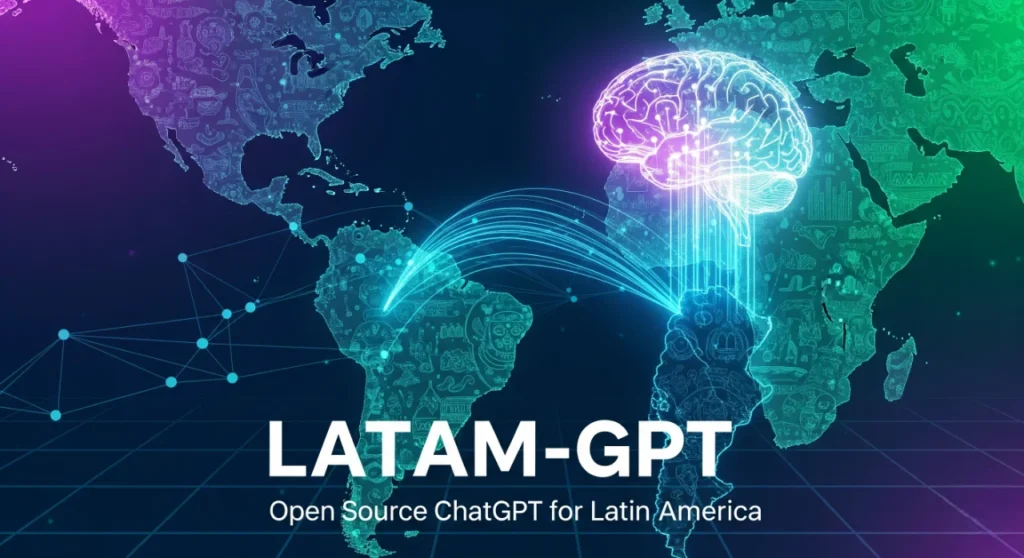Latin America is building its own ChatGPT.
A coalition led by Chile’s National Center for Artificial Intelligence (CENIA) has unveiled Latam-GPT, an open source large-language model trained on millions of regional documents. The project is designed to give Latin America technological independence from US and Chinese AI giants—and it’s launching this year.
Key Takeaways
- Latam-GPT is Latin America’s first large open source AI model.
- Trained on 2.6M+ documents across 20 countries and Spain.
- Built with $10M in supercomputing power in Chile.
- Aims for regional tech independence, not to rival OpenAI or Google.
- First release launches in 2025 with local applications in education, health, and culture.
Latam-GPT is a large-language model developed by Chile’s National Center for Artificial Intelligence (CENIA) to serve Latin America. Trained on over 2.6 million documents from across the region, it aims to provide cultural and linguistic relevance while remaining fully open source. Its first public release is set for 2025.
A Regional Answer to Big Tech
Latin America is entering the global AI race with its own flagship project: Latam-GPT. Unlike ChatGPT or Google’s Gemini, this model is being built specifically for Latin America’s cultural, linguistic, and political landscape. The initiative, led by Chile’s National Center for Artificial Intelligence (CENIA), is pitched as a collaborative alternative to Silicon Valley’s closed systems.
“We’re not looking to compete with OpenAI or Google,” says CENIA director Álvaro Soto. “We want a model for Latin America and the Caribbean—aware of our dialects, history, and cultural needs.”
Inside the Numbers
The team has assembled a training corpus of 2.6 million documents (≈8 terabytes of text) from 20 Latin American countries and Spain. Brazil leads with 685,000 documents, followed by Mexico (385,000), Spain (325,000), Colombia (220,000), and Argentina (210,000).
The model itself has 50 billion parameters, putting it in the same weight class as GPT-3.5. That gives Latam-GPT the ability to handle advanced reasoning, translations, and contextual associations, with deeper accuracy on Latin America–specific queries.
Why It Matters
For decades, Latin America has relied on imported technologies. Latam-GPT is framed as a step toward technological sovereignty—not just consuming AI, but building it. That shift has implications beyond tech.
If successful, the model could reshape education, health care, and agriculture by providing localized AI tools. Imagine a Colombian ministry fine-tuning Latam-GPT for schools, or a Brazilian hospital adapting it for patient care in Portuguese.
The Infrastructure Gamble
AI development requires massive computing power. To meet the challenge, Chile’s University of Tarapacá is hosting a new $10 million supercomputing cluster with NVIDIA H200 GPUs—unprecedented capacity in the region. Soto calls computing power “the football field” of this new era: without it, Latin America can’t even play the game.
Data and Cultural Roots
Unlike commercial models optimized for English or Mandarin, Latam-GPT prioritizes regional diversity. Its training set includes indigenous cultural data (Aztecs, Incas, Mapuche) and is being expanded to cover indigenous languages such as Mapuche, Rapanui, and Guaraní.
The first release will not be perfect. But CENIA’s approach—open source and collaborative—means institutions across Latin America can adapt it for niche uses, building a family of models over time.
Global Implications
Tech sovereignty is not a new theme, but Latam-GPT shows how AI is fracturing into regional ecosystems. Europe has Mistral AI, China has DeepSeek and Baidu’s ERNIE, and now Latin America has Latam-GPT.
For global firms, it signals a future where AI is less about one global “winner” and more about localized dominance. For governments, it’s a reminder that AI strategy is now as much about cultural representation as technical performance.
What Happens Next
The first public release of Latam-GPT is planned for 2025. As new partners and data sources are added, larger models with image and video capabilities are expected.
Looking ahead to 2030, Soto envisions success as “tools that speak to us in our context—with figures from our history, not just examples from abroad.”
Conclusion
Latam-GPT may not rival OpenAI in raw scale, but that isn’t the point. It’s about building AI that belongs to Latin America—technologically, culturally, and politically. For a region long sidelined in global tech, that could prove revolutionary.
